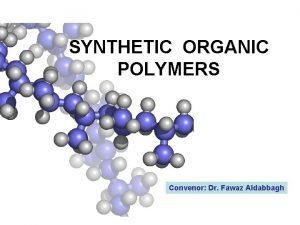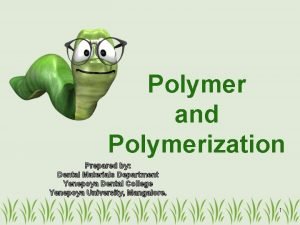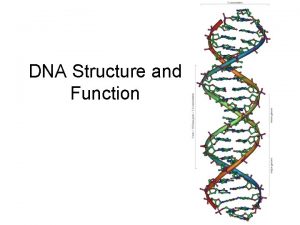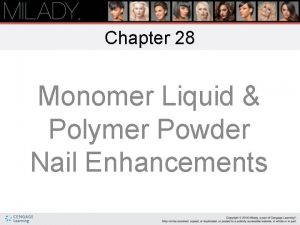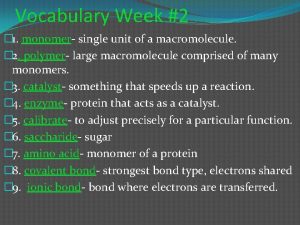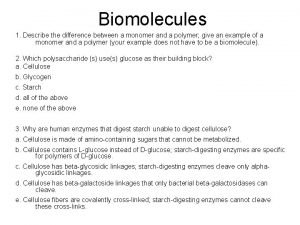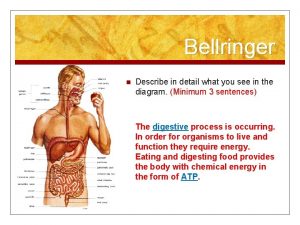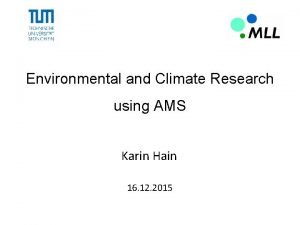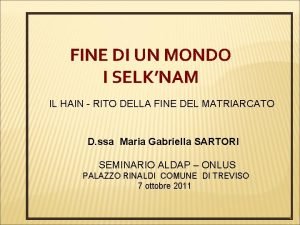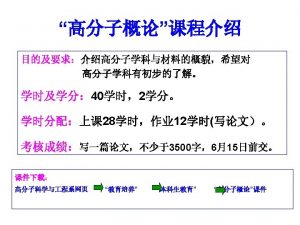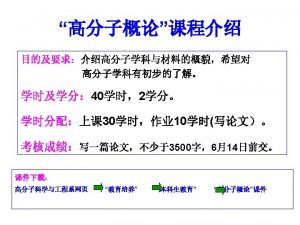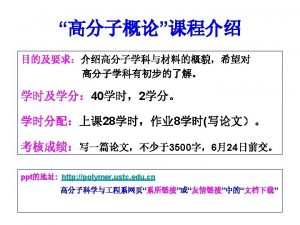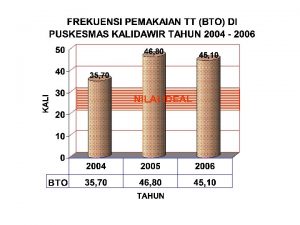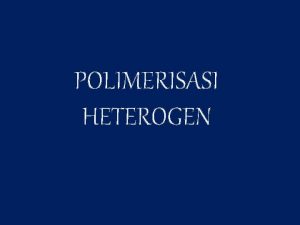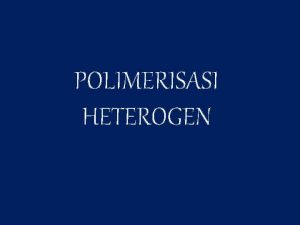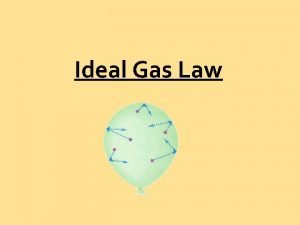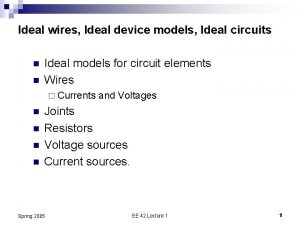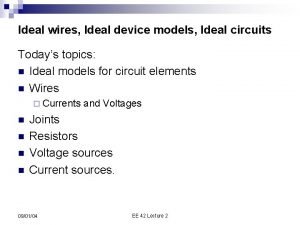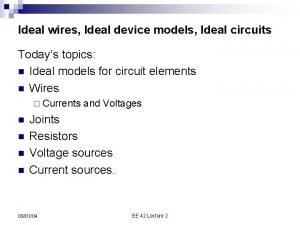Ideal polymer hain interactions of monomer units which














- Slides: 14

Ideal polymer сhain: interactions of monomer units which are far from each other along the chain are neglected. Polymer chains behave as ideal ones in the socalled - conditions (see below). Let us consider ideal N-segment freely-jointed chain ( each segment of length l ). O - end-to-end vector, The size of the coil is characterized by

O (different segments are uncorrelated) L - contour length of the chain , Thus, the conformation of an ideal chain is far from the rectilinear one. Ideal chain forms an entangled coil. The chain trajectory is equivalent to the trajectory of a Brownian particle.

Model with fixed valency angle The conclusion R~N 1/2 is valid for ideal chain with any flexibility mechanism. E. g. , let us consider the model with fixed valency angle between the segments of length b and free internal rotation ( ). As before but now - angle between segments i and j

By continuing these arguments, we have

Conclusions • Average size of the macromolecule is proportional to for this model we have entangled coil as well. This is a general property of ideal polymer chains independently of the model. • At the value of R is larger than for the freely-jointed chain. At relationship is reverse. the

Persistent Length of a Polymer Chain Let us return to the formula derived for the model with fixed valency angle Here s=kb is the contour distance between two monomer units along the chain.

This formula was derived for the model with fixed valency angle , but it is valid for any model: orientational correlations decay exponentially along the chain. The characteristic length of this decay, , is called a persistent length of the chain. At s << the chain is approximately rectilinear, at s >> the memory of chain orientation is lost. Thus, different chain segments of length can be considered as independent, and Therefore, R is always proportional to .

Kuhn Segment Length of a Polymer Chain We know that for ideal chain Kuhn segment length l is defined as (at large L) Thus the equality is exact by definition. Advantage of l : it can be directly experimentally measured. Advantage of : it has a direct microscopic meaning. We always have. Let us examine this relationship for the model with fixed valency angle. Since On the other hand,

Stiff and Flexible Chains Now we have a quantitative parameter that characterizes the chain stiffness: Kuhn segment length l (or persistent length ). The value of l is normally larger than the contour length per monomer unit The ratios shown below. . for most common polymers are

d l From macroscopic viewpoint a polymer chain can be represented as a filament characterized by two lengths: • Kuhn segment l • characteristic chain diameter d Stiff chains: l >> d (DNA, helical polypeptides, aromatic polyamides etc. ) Flexible chains: (most carbon backbone polymers)

Polymer Volume Fraction Inside Ideal Coil End-to-end vector is the volume of the coil . Polymer volume fraction within the coil is very small for long chains.

Radius of Gyration of Ideal Coil Center of mass of the coil , where is the coordinate of the i-th monomer unit. Radius of gyration, by definition, is. It can be shown that for ideal coils. The value of can be directly measured in the light scattering experiments (see below).

Gaussian Distribution for the End-to-End Vector for Ideal Chain -probability distribution for the end-toend vector of N - segment freely-jointed chain. Since each step gives independent contribution to , by analogy with the trajectory of a Brownian particle -Gaussian distribution. Therefore, the ideal coil is sometimes called a Gaussian coil. Since is a probability distribution, . Also, .

The value of undergoes strong fluctuations. For other models, since orientational correlations decay exponentially, Gaussian distribution is still valid: This form of specific model. is independent of any
 Polymerization of monomers
Polymerization of monomers Dental monomer and polymer
Dental monomer and polymer Nucleic acid monomer
Nucleic acid monomer What is the proper procedure for applying one color monomer
What is the proper procedure for applying one color monomer Psady reviews
Psady reviews Monomer polymer vocabulary ws answers
Monomer polymer vocabulary ws answers Monomer
Monomer Biomolecules graphic organizer
Biomolecules graphic organizer Jennifer hain teper
Jennifer hain teper Mll munich
Mll munich Components of 8051 microcontroller
Components of 8051 microcontroller Informal and formal letter
Informal and formal letter Rito hain
Rito hain Botox markings
Botox markings When units manufactured exceed units sold:
When units manufactured exceed units sold:
